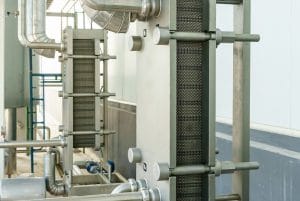 The value in modern electrical thermal management systems can be measured in many different ways, depending on the application for which it’s used. For instance, the rate at which it can eliminate or transfer waste heat is important in helping applications operate at optimal capacity. The level of protection the system offers is important to ensuring thermal management operations remain safe from contamination and the complications that it could cause. In many cases, air-to-air cooling the optimal solution for meeting most modern thermal management needs. With heat exchangers, companies can often find the specific air-to-air cooling solution that suits their needs best and helps make operations more efficient as a result.
The value in modern electrical thermal management systems can be measured in many different ways, depending on the application for which it’s used. For instance, the rate at which it can eliminate or transfer waste heat is important in helping applications operate at optimal capacity. The level of protection the system offers is important to ensuring thermal management operations remain safe from contamination and the complications that it could cause. In many cases, air-to-air cooling the optimal solution for meeting most modern thermal management needs. With heat exchangers, companies can often find the specific air-to-air cooling solution that suits their needs best and helps make operations more efficient as a result.
What air-to-air cooling means these days
Air-to-air cooling can be achieved in several different ways. In modern technological applications, it’s often accomplished by using an eco-friendly cooling fluid to keep an electrical enclosure cooled to just above the ambient temperature inside of it. As electrical waste heat is generated, the fluid carries it away before it can accumulate within the enclosure, then releases it safely where it can’t cause damage. Fortunately, most modern applications have maximum operating temperatures that are far above the ambient temperature outside of their enclosures. Because air-to-air cooling consists of largely natural processes, it’s also a much more efficient and eco-friendly way to achieve high-performance electrical cooling.
Making it feasible with heat exchangers
Before heat exchangers, air-to-air cooling wasn’t as reliable or efficient as applications demanded. However, heat exchangers made it a productive and easily manageable process by utilizing eco-friendly cooling fluids and easily adaptable designs, such as heat pipes and cold plates. The design of a heat exchanger can be customized according to an application’s specific needs, including providing specific levels of heat transfer or maintaining specific below-ambient temperatures. Their high customizability makes heat exchangers often the ideal solution
Advantages that come with modern heat exchangers
One of the greatest advantages of air-to-air cooling is that it doesn’t require complicated machinery or different types of chemicals to work. Heat exchangers turn natural heat transfer processes into an advantage by making electrical thermal management more cost-effective and eco-friendly. This has helped companies continuously save money while also boosting the efficiency of their technologies, and therefore, their overall productivity and profitability. For more information about how many costs air-to-air cooling can help companies reduce, call Noren Thermal Solutions in Taylor, TX, at 866-936-6736.







